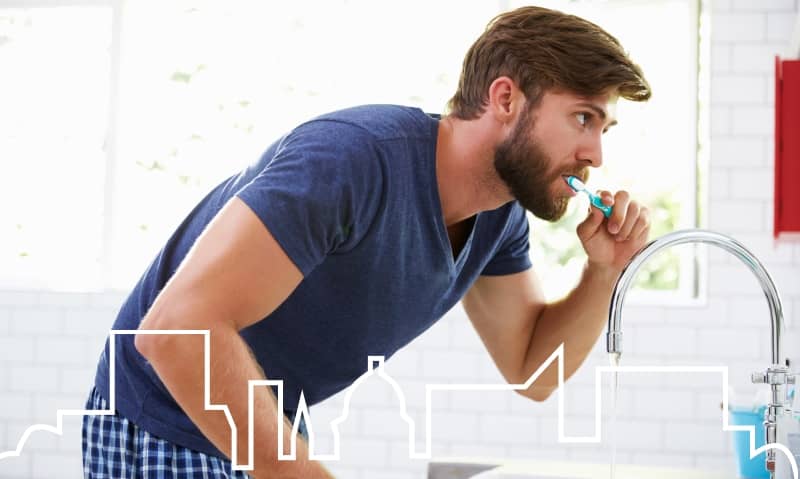3 Signs You’re Not Brushing and Flossing Your Teeth Properly

Visiting your dentist regularly is essential, but caring for your teeth properly at home is equally important. It’s not always easy to know whether you are brushing and flossing correctly, though. Improper technique can make you miss key areas of your mouth, allowing plaque to build and cavities to develop.
Fortunately, flossing and brushing your teeth properly is not difficult to accomplish. You just need to follow some simple tips, and keep an eye out for a few key signs that might be telling you your current oral hygiene routine is not doing the job.
Brushing and Flossing Alerts
Here are three hints that you may not be flossing and brushing your teeth properly.
1. Your gums bleed when you floss.
Your gums should not bleed very easily. So if flossing or brushing causes your gums to bleed, it could be a sign you have gingivitis.
Gingivitis is the first stage of gum disease, and it almost always occurs due to poor oral hygiene—a lack of proper flossing in particular. While this stage of gum disease is curable, if it advances any further, it can only be treated, not cured.
Gum disease can lead to all kinds of issues beyond bleeding gums as well. Those issues include painful chewing, tooth sensitivity, and gum recession. You may also be at increased risk for dental abscesses, loose teeth, and tooth loss.
2. Your teeth are sensitive to hot and cold.
If you find that you brush your teeth and floss consistently and your teeth become sensitive to hot and cold, you may be brushing too hard. Forceful brushing can wear away your gum tissue, exposing the extra sensitive tooth roots.
If you’d like to avoid this issue, you can switch to an electric toothbrush or opt for an extra soft-bristled brush.
3. Your teeth feel different after a dental cleaning.
After any dentist appointment that includes dental cleaning, your teeth are likely to feel smoother than they have in a long time. But if the difference is particularly pronounced, that may mean you’re not brushing properly at home. You should be brushing until your teeth feel completely free of plaque and food debris.
How to Brush Your Teeth Properly
When it comes to brushing your teeth properly, it’s vital to brush your teeth twice a day, every day. And if you want to be extra cautious, you can brush after every meal.
Here are a few simple tips you’ll want to follow to brush your teeth properly.
1. Use the right toothbrush and toothpaste.
You’ll want to ensure your toothbrush is not too hard and that both it and your toothpaste are ADA recommended.
2. Follow a pattern.
You should start brushing the outer surfaces of your teeth first, moving the brush in small circles to loosen up plaque and food debris. Next, brush the inner surfaces, and then the chewing surfaces. Following this pattern each time you brush will help ensure that every tooth gets the attention it needs.
If you are using an electric toothbrush, you only need to move your toothbrush along your teeth, without any back-and-forth motions—the toothbrush will do the work for you. Just make sure to reach all sides of your teeth when you use an electric toothbrush.
3. Brush your tongue.
Often, bad breath is the result of bacteria residing on the back of the tongue. To keep your breath fresh, brush your tongue after you’ve brushed your teeth.
How to Floss Your Teeth Properly
You can floss with a few different tools, including traditional dental floss, dental flossers, or a water flosser. Regardless of which tool you choose, the main goal is to clean the areas in between the teeth and below the gumline where a toothbrush cannot.
Improper flossing can wind up leaving plaque and food debris behind, leading to the risk of developing cavities and gum disease.
1. Follow a pattern.
Just as with brushing your teeth, you’ll want to follow the same pattern when you floss every time, so you don’t skip teeth by accident. It doesn’t matter where you start or where you end; it only matters that you are consistent.
2. Floss in a C shape.
You may be tempted to move the floss back and forth, perpendicular to your teeth, but the most effective way to floss is to bend it around your tooth so that it forms a C shape, and then gently move it back and forth, up and down.
3. Rinse when you’re done.
If you dislodge any debris while you’re flossing, a good rinsing with water afterward should help clear it out.
Need a family dentist in Boise, ID?
At Staley Dental, your comfort matters. If you’re looking for a skilled dentist in Boise who can help your family maintain good oral hygiene in a state-of-the-art facility, contact Staley Dental today to schedule an appointment.